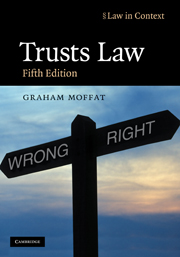Book contents
- Frontmatter
- Contents
- Preface to the fifth edition
- Acknowledgments
- Table of abbreviations
- Useful websites
- Table of statutes
- Table of statutory instruments
- Table of cases
- 1 Trusts introduced
- 2 The evolution of the private express trust
- 3 Taxation, wealth-holding and the private trust
- 4 Creating the trust – I
- 5 Creating the trust – II
- 6 Trusts and public policy
- 7 Flexibility in relation to beneficial entitlement
- 8 The taxation of private trusts
- 9 An introduction to trustees and trusteeship
- 10 Aspects of the management of trusts
- 11 Trusteeship, control and breach of trust
- 12 Implied trusts and the family home
- 13 Trusts in commerce I: occupational pension schemes
- 14 Trusts in commerce II: commerce and equitable remedies
- 15 Trusts in commerce III: commerce, credit and the trust
- 16 Trusts in commerce IV: fiduciary relationships, commerce and the trust
- 17 Trust, contract and unincorporated associations
- 18 An introduction to the law of charity
- 19 A legal definition of ‘charity’
- 20 The regulation of charities
- Index
5 - Creating the trust – II
- Frontmatter
- Contents
- Preface to the fifth edition
- Acknowledgments
- Table of abbreviations
- Useful websites
- Table of statutes
- Table of statutory instruments
- Table of cases
- 1 Trusts introduced
- 2 The evolution of the private express trust
- 3 Taxation, wealth-holding and the private trust
- 4 Creating the trust – I
- 5 Creating the trust – II
- 6 Trusts and public policy
- 7 Flexibility in relation to beneficial entitlement
- 8 The taxation of private trusts
- 9 An introduction to trustees and trusteeship
- 10 Aspects of the management of trusts
- 11 Trusteeship, control and breach of trust
- 12 Implied trusts and the family home
- 13 Trusts in commerce I: occupational pension schemes
- 14 Trusts in commerce II: commerce and equitable remedies
- 15 Trusts in commerce III: commerce, credit and the trust
- 16 Trusts in commerce IV: fiduciary relationships, commerce and the trust
- 17 Trust, contract and unincorporated associations
- 18 An introduction to the law of charity
- 19 A legal definition of ‘charity’
- 20 The regulation of charities
- Index
Summary
Introduction
On one level this chapter is simply concerned with completing the description of the necessary requirements for creating a valid express trust. This process provides a snapshot of the present rules relating to ‘certainty of objects’ and the ‘beneficiary principle’ whilst simultaneously identifying unresolved problems and teasing out inconsistencies. But as in other areas of law, the rules have not remained static and change here has been dramatic. Indeed during the last four decades the courts have so turned the world of ‘certainty of objects’ upside down that ‘the forms and functions of settlements have changed to a degree which would have astonished Lord Eldon’ (Schmidt v Rosewood Trust Ltd [2003] 2 AC 709 at para 34 per Lord Walker). This dynamic aspect of law-making also deserves attention. A second level of study, therefore, is to examine the shifts that have occurred and to understand the how and why of change.
However, the starting place for this study has to be traced back much further, to the decision in Morice v Bishop of Durham (1804) 9 Ves 399. There Sir W Grant summarised the court's approach as follows:
There can be no trust, over the exercise of which this Court will not assume a control; for an uncontrollable power of disposition would be ownership, and not trust. If there be a clear trust, but for uncertain objects, the property, that is the subject of the trust, is undisposed of, and the benefit of such trust must result to those, to whom the law gives the ownership in default of disposition by the former owner. […]
- Type
- Chapter
- Information
- Trusts LawText and Materials, pp. 206 - 266Publisher: Cambridge University PressPrint publication year: 2009



